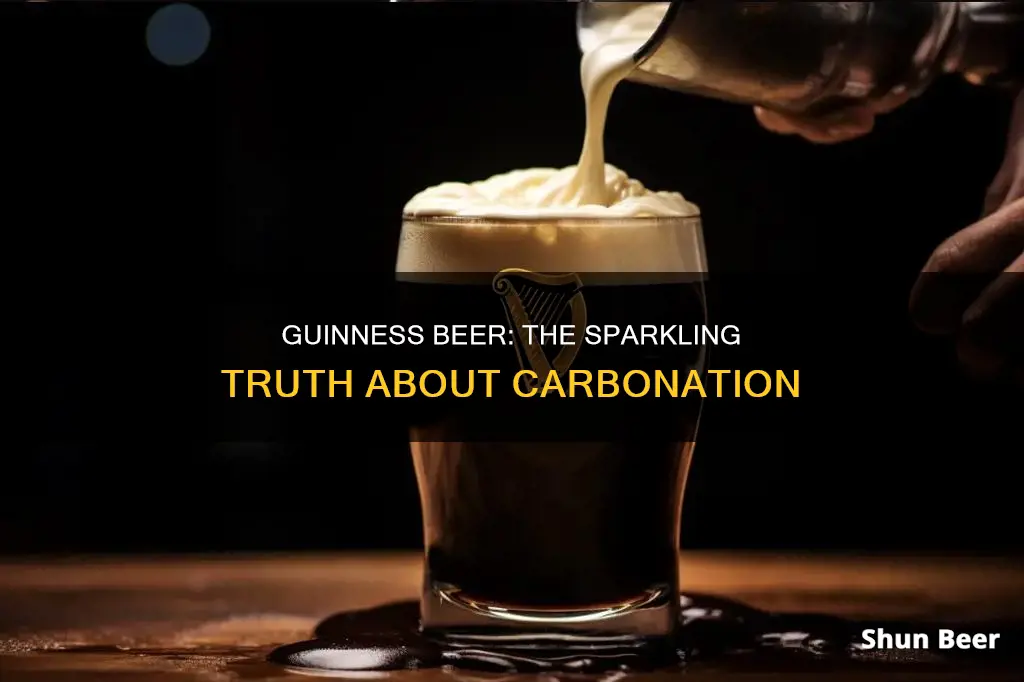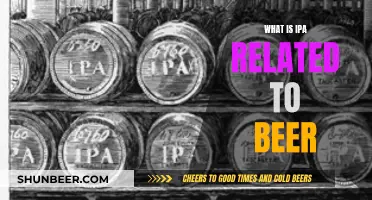
Guinness is a traditional Irish stout beer, brewed in St. James' Gate in Dublin since 1759. It is known for its distinctive flavour, eye-catching colour, and creamy texture. While Guinness is carbonated, it has less carbonation than regular lagers, creating a smoother and more delicate mouthfeel. The carbonation in Guinness is achieved using a mixture of carbon dioxide and nitrogen, resulting in smaller bubbles and a creamier texture compared to beers carbonated solely with carbon dioxide. The nitrogenation process gives Guinness its signature creamy head and contributes to its unique taste and appearance.
| Characteristics | Values |
|---|---|
| Carbonation | Yes |
| Carbonation type | Natural and forced |
| Carbonation gas | Nitrogen and carbon dioxide |
| Nitrogen/carbon dioxide ratio | 75/25 or 70/30 |
| Mouthfeel | Creamy, smooth, velvety |
| Bubbles | Smaller |
| Fizziness | Less than regular lagers |
What You'll Learn

Guinness is carbonated with a blend of carbon dioxide and nitrogen
Guinness is a traditional Irish stout beer that has been brewed in Dublin since 1759. It is carbonated, like most beers, but differs from other beers in that it uses a blend of carbon dioxide and nitrogen. This blend is what gives Guinness its signature creamy head and mouthfeel.
The use of nitrogen in Guinness was first introduced by Michael Ash in 1951. Instead of using carbon dioxide to carbonate the beer, Ash used nitrogen to create smaller bubbles and a creamier, smoother mouthfeel. This mixture of nitrogen and carbon dioxide is what gives Guinness its unique "surge and settle" effect when poured.
The typical ratio of nitrogen to carbon dioxide in Guinness is 75% nitrogen to 25% carbon dioxide. This blend creates a rich and velvety texture that takes a little while to settle when poured. The smaller bubbles created by nitrogen also give the beer a thicker, more velvety "mouthfeel" without the acidic bite of carbonation with carbon dioxide.
To recreate the surge and settle effect in canned Guinness, the company developed a widget, a tiny plastic ball that is placed inside the can. During canning, pressurized nitrogen is added to the brew, which fills the widget. When the can is opened, the nitrogenated beer is released from the widget and mixes with the rest of the beer, creating the iconic foamy head of a draught Guinness.
So, while Guinness is carbonated, it is the blend of carbon dioxide and nitrogen that sets it apart from other beers and gives it its unique characteristics.
Guinness Beer: German or Irish?
You may want to see also

Nitrogen creates smaller bubbles and a creamier mouthfeel
The smaller nitrogen bubbles are also more stable. So, when you open a can or bottle of Guinness, more of the bubbles stay intact, giving the beer a thicker, more velvety "mouthfeel" without the acidic bite of carbonation with CO2. This is why Guinness has a lighter, velvety mouthfeel than other beers.
The use of nitrogen in Guinness is also what creates its signature cascading pour. When a "normal" beer is carbonated with carbon dioxide, it is served with carbon dioxide or a mixture of carbon dioxide and nitrogen at a ratio of 60/40. Guinness, on the other hand, is carbonated and served with a blend of carbon dioxide and nitrogen at a ratio of 30/70 or 25/75. The cascading effect seen when Guinness is poured is caused by the nitrogen leaving the pint rapidly. Once the pint has settled, you are left with a slightly under-carbonated ale with a creamy nitrogen head.
Guinness and Breastfeeding: To Pump or Not?
You may want to see also

Guinness Extra Stout uses carbonation, not nitrogen
Guinness Extra Stout is a unique, one-of-a-kind beer that has been around for over 200 years. While Guinness Draught, available in most pubs and bars worldwide, is often synonymous with the Guinness brand, the Extra Stout is a less well-known variant. Interestingly, the Extra Stout does not contain nitrogen widgets; instead, it relies solely on carbonation, resulting in a bubblier texture than its draught counterpart.
The carbon dioxide bubbles in Guinness Extra Stout create a distinctive "cascading" effect, although it doesn't last long, nor does the head. The aroma is noticeably maltier, with hints of chocolate and coffee, and perhaps a touch of hops. The colour is a shade lighter than the Draught, revealing a dark reddish-brown hue near the edges of the glass.
In terms of mouthfeel and taste, Guinness Extra Stout offers a distinct bite. It has a heavier body, a maltier flavour, carbonation, and a more bitter aftertaste with a hint of sourness. The added roastiness of the malt enhances the overall flavour, making it a truer representation of an Irish dry stout. Despite the "Extra" in the name, the alcohol content is well-masked, as is typical of Guinness beers.
The Extra Stout provides a unique drinking experience that differs from the silky smoothness of the draught version. It is a must-try for any stout enthusiast, especially those interested in exploring the world of American craft-brewed stouts. While it may not have the same nitrogen-induced creaminess as the draught, the carbonation in Guinness Extra Stout creates a distinct character that sets it apart within the Guinness family.
Guinness Beer: Kosher Certification and Jewish Drinking Traditions
You may want to see also

Guinness has a two-stage pour to allow for nitrogen to settle
Guinness is a traditional Irish stout beer that is brewed in St. James' Gate in Dublin. It is carbonated, like most beers, but has less carbonation than regular lagers. It is carbonated using a mixture of carbon dioxide and nitrogen, which creates a creamy mouthfeel and smaller bubbles, resulting in a less fizzy experience compared to other beers.
The unique two-part pour method of Guinness dates back to the 1930s and was initially used to address the challenge of serving Guinness from two types of casks: highly conditioned and low-conditioned casks. Bartenders had to fill the glass three-quarters full with beer from the low cask before topping it off with beer from the high cask, which was a complex process with no standard technique.
In 1951, Guinness hired mathematician-turned-brewer Michael Ash, who introduced nitrogen gas as a solution to the pouring problem. After extensive testing, Nitro Guinness Stout was launched in 1959, coinciding with the brewery's 200th anniversary. The two-part pour remained, but now served a different purpose: to showcase the beauty of the beer as it transforms and to ensure the head is the ideal size.
The two-stage pour involves first pouring Guinness into a glass tilted at a 45-degree angle until it is three-quarters full. Then, the glass is placed on the counter to rest, allowing the nitrogen bubbles to travel down the side of the glass and then return to the top by moving up through the centre of the beer. This process creates the creamy head that characterises Guinness. Finally, the glass is topped off with more beer.
Guinness recommends letting the beer rest for 1 minute and 32.5 seconds, or even up to two minutes, to achieve the perfect pour. This waiting period is not only functional but also serves as a marketing strategy, creating a memorable drinking experience.
The Origins of Guinness Beer: A Historical Overview
You may want to see also

Guinness has a widget in cans to release nitrogen when opened
Guinness Beer is a traditional Irish stout beer that has been brewed in St. James' Gate in Dublin since 1759. It is known for its distinctive flavour, eye-catching colour, and creamy texture. The carbonation process of Guinness Beer involves a mixture of natural and forced carbonation, using nitrogen instead of carbon dioxide to create smaller bubbles and a creamier mouthfeel. This nitrogen-carbonation process was revolutionised by Michael Ash, who joined Guinness in 1951 and wanted to serve the beer in draught form.
To recreate the draught effect in cans, Guinness introduced a widget; a small, nitrogen-filled ball placed inside the can. This widget is a tiny, hollow, spherical piece of food-grade plastic with a small hole, and it plays a crucial role in delivering the signature Guinness experience. During the canning process, pressurised liquid nitrogen is added to the brew, which quickly evaporates, creating pressure that forces gas and liquid into the widget. When the can is opened, the gas and liquid escape from the widget with a "pssshhh" sound, mixing with the beer to create the iconic foamy head. This slow release of nitrogen into the beer upon opening ensures that the nitrogenated beer has a velvety texture, similar to a pint of draught Guinness.
The widget was first patented by Guinness in 1969, but the initial version had some issues. The first-generation widget, released in 1989, was a flattened disc that worked well with cold beer but could cause overflow if the beer was warm. To address this, Guinness introduced an improved version in 1997—a floating, spherical widget called the "smoothifier." This widget has been a game-changer, ensuring that each can of Guinness delivers the same smooth, creamy texture that has become synonymous with the brand.
The use of nitrogen instead of carbon dioxide in Guinness Beer results in smaller bubbles and a smoother, more delicate taste. This unique nitrogenation process sets Guinness apart from other beers and contributes to its iconic status.
Guinness Beer's Dark Appearance: A Black Mystery Solved
You may want to see also
Frequently asked questions
Yes, Guinness beer is carbonated.
Guinness uses a mixture of natural and forced carbonation. The natural carbonation is a result of the brewing process, where the sugars in the barley are eaten by the yeast, releasing CO2 gases which end up carbonating the beer. For the forced carbonation, brewers pump nitrogen into the keg after the fermentation process.
The use of nitrogen instead of carbon dioxide to carbonate the beer results in smaller bubbles and a creamier mouthfeel, which means it doesn’t have the ‘fizzy’ experience most other beers have.







